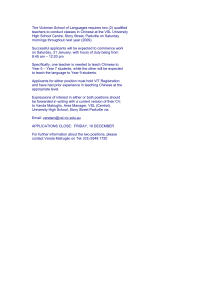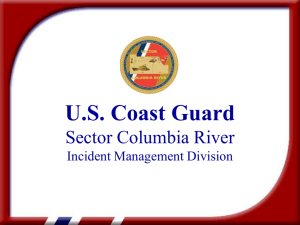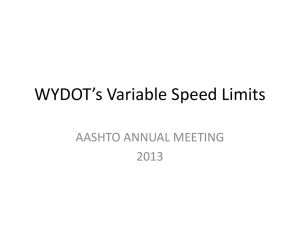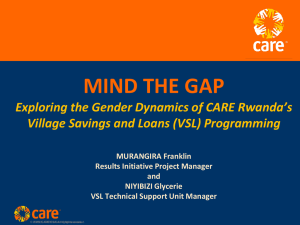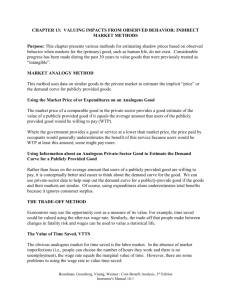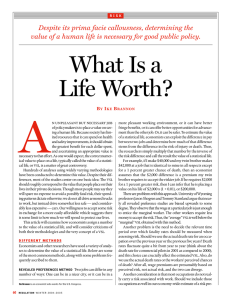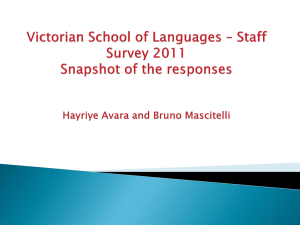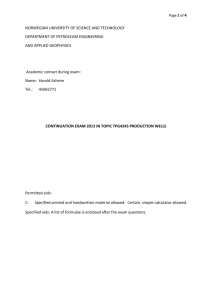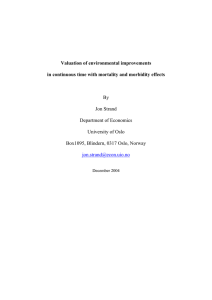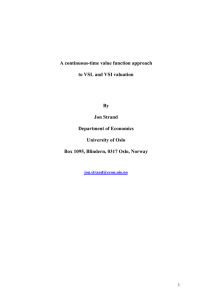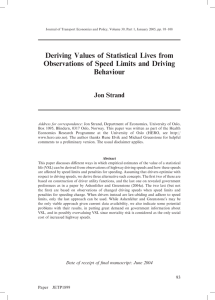Chapter 16 - Benefit-Cost Analysis MAST672/ECON670
advertisement
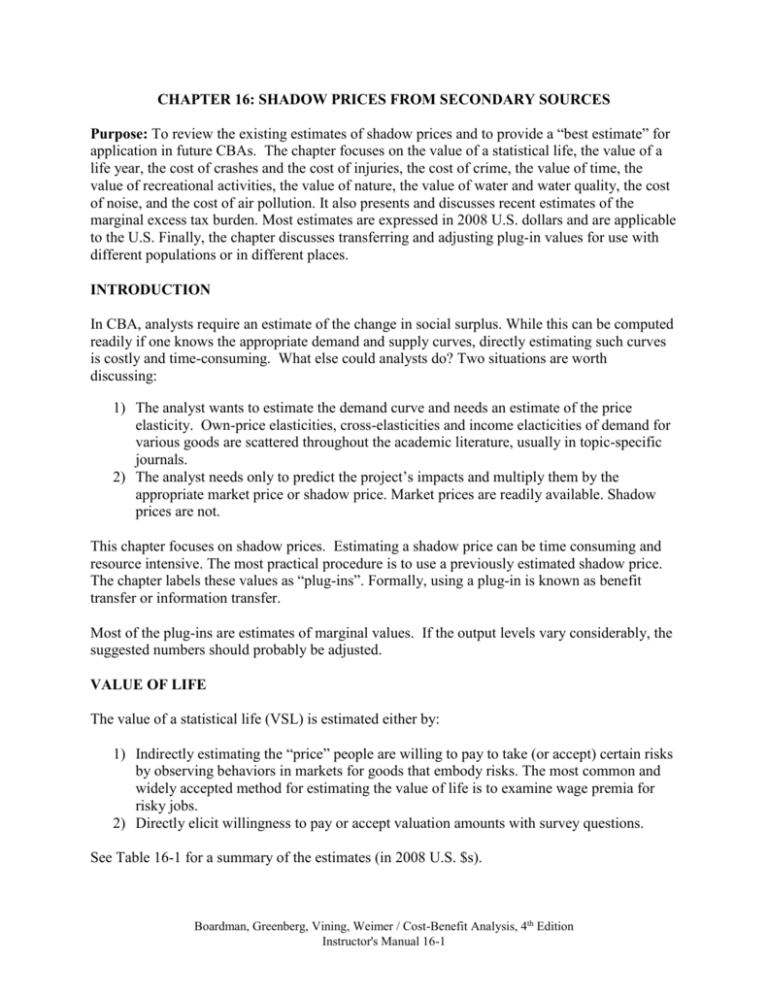
CHAPTER 16: SHADOW PRICES FROM SECONDARY SOURCES Purpose: To review the existing estimates of shadow prices and to provide a “best estimate” for application in future CBAs. The chapter focuses on the value of a statistical life, the value of a life year, the cost of crashes and the cost of injuries, the cost of crime, the value of time, the value of recreational activities, the value of nature, the value of water and water quality, the cost of noise, and the cost of air pollution. It also presents and discusses recent estimates of the marginal excess tax burden. Most estimates are expressed in 2008 U.S. dollars and are applicable to the U.S. Finally, the chapter discusses transferring and adjusting plug-in values for use with different populations or in different places. INTRODUCTION In CBA, analysts require an estimate of the change in social surplus. While this can be computed readily if one knows the appropriate demand and supply curves, directly estimating such curves is costly and time-consuming. What else could analysts do? Two situations are worth discussing: 1) The analyst wants to estimate the demand curve and needs an estimate of the price elasticity. Own-price elasticities, cross-elasticities and income elacticities of demand for various goods are scattered throughout the academic literature, usually in topic-specific journals. 2) The analyst needs only to predict the project’s impacts and multiply them by the appropriate market price or shadow price. Market prices are readily available. Shadow prices are not. This chapter focuses on shadow prices. Estimating a shadow price can be time consuming and resource intensive. The most practical procedure is to use a previously estimated shadow price. The chapter labels these values as “plug-ins”. Formally, using a plug-in is known as benefit transfer or information transfer. Most of the plug-ins are estimates of marginal values. If the output levels vary considerably, the suggested numbers should probably be adjusted. VALUE OF LIFE The value of a statistical life (VSL) is estimated either by: 1) Indirectly estimating the “price” people are willing to pay to take (or accept) certain risks by observing behaviors in markets for goods that embody risks. The most common and widely accepted method for estimating the value of life is to examine wage premia for risky jobs. 2) Directly elicit willingness to pay or accept valuation amounts with survey questions. See Table 16-1 for a summary of the estimates (in 2008 U.S. $s). Boardman, Greenberg, Vining, Weimer / Cost-Benefit Analysis, 4th Edition Instructor's Manual 16-1 Miller VSL Estimates Miller undertook a meta-analysis of 68 international studies. He estimates the mean VSL = $4.88M, with a range from $4.4M to $6.1M. Mrozek and Taylor VSL Estimates These researchers undertook a meta-analysis of 33 international VSL studies. The mean VSL was roughly $7.7M. They are suspect of VSl estimates from labor market studies that propose high values because these studies overlook the importance of controlling for unobservable factors at the industry level. When also controlling for industry effects (by using dummy variables), Mrozek and Taylor predict a VSL of $3.3M for the average worker. Viscusi and Aldy Survey of VSL Estimates Viscusi and Aldy examine 49 wage-risk studies, more than half of which are from the US. They have most confidence in estimates near $6.6M to $7.8M. Kochi, Hubbell, and Kramer Analysis of VSL Estimates Kochi, Hubbell, and Kramer conducted a meta-analysis on 31 hedonic wage-risk studies and 14 contingent valuation studies. In computing the mean VSL, they gave greater weight to estimates with greater levels of statistical significance. They computed a mean VSL of 6.8M with a standard deviation of $3.0M. Conclusion For the US, the chapter suggests using a point estimate of $5M for the VSL, with sensitivity analysis at $3M and $7M. THE VALUE OF A LIFE YEAR, VLY The value of a life year is the constant annual amount which, taken over a person’s remaining life span, had a discounted value equal to his or her VSL. Assuming the VLY is constant it can be computed from an estimate of the average VSL, denoted VSL : VLY = VSL A(T a, r ) (16.1) where, A(T-a,r) is the annuity factor based on the expected number of remaining years of life, Ta, and the discount rate, r. Using an average VSL of $5M, a discount rate of 3.5 percent and a life expectancy of 40 years implies the VSL equals $234,136. A quality-adjusted life year, QALY, weights the VLY by the quality of health during that year, denoted wt: Boardman, Greenberg, Vining, Weimer / Cost-Benefit Analysis, 4th Edition Instructor's Manual 16-2 QALYt = wtVLY (16.3) THE COST OF CRASHES AND THE COST OF INJURIES These cost estimates are summarized in Table 16-1. Rice-MacKenzie and Associates Estimates of the Cost of Injuries The Rice-MacKenzie estimates of the cost of injuries focus on the direct medical costs: They include medical and rehabilitation costs and forgone earnings, but they do not include pain and suffering that people would pay to avoid. They do not include property damage losses, court costs, etc. This “human capital” approach leads to underestimation of the social cost of injuries. Miller and Galbraith Estimates Miller and Galbraith estimate the cost of occupational injuries in the U.S. using a method similar to Rice-MacKenzie but including a measure of WTP to avoid the disutility associated with injuries. Dillingham, Miller and Levy Estimates of the Cost of Injuries Based on a wage-risk study, the authors estimate that individuals are willing to pay between $160,200 and $249,000 per year to avoid one year of impairment. Zaloshnja, Miller, Romano and Spicer Estimates of the Cost of Motor Vehicle Crash Injuries This study provides a comprehensive estimate of the cost of damage to a large spectrum of body parts injured in motor vehicle crashes. The estimates include the cost of medical and emergency services, household and workplace productivity losses, insurance and legal costs, property damage loss, and loss of quality of life. Injuries to each body part are broken down by level of severity, based on the most severe (“maximum”) injury sustained by a person according to the (Maximum) Abbreviated Injury Scale, AIS or MAIS, which is shown in Table 16-2. This table also shows the fraction of a VSL corresponding to each level of severity as suggested by Miller. Blincoe and Colleagues Estimates of the Cost of Motor Vehicle Crashes This study provides fully allocated costs of motor vehicle crashes. The cost of each component of social cost (such as medical costs or quality adjusted life year [QALY]) for property damage only and 6 AIS levels of crash severity are shown in Table 16-3. Boardman, Greenberg, Vining, Weimer / Cost-Benefit Analysis, 4th Edition Instructor's Manual 16-3 COST OF CRIME Many public programs in education, criminal justice, and social welfare have reduced crime as a goal. Table 16.4 provides estimates of the victim cost and criminal justice cost of various types of violent crime. Miller, Cohen and Wiersema Estimates of the Cost of Crime The authors focus on the victims’ costs. They include police/fire services but ignore criminal justice system costs and the cost of actions taken to reduce the risk of becoming a crime victim, which are two of the largest components of the cost of criminal behavior. Cohen Estimates of Criminal Justice Costs Cohen uses administrative data and the probability that an offender will be detected and punished to estimate criminal justice-related costs for five types of violent crime. Cohen, Rust, Steen, and Tidd Estimates of WTP for Crime Control Programs Based on a contingent valuation survey, Cohen and his colleagues attempted to determine the total national WTP for reductions in different types of violent crime. These estimates tend to be considerably larger than costs determined by other means, possibly in part because they capture some cost that other approaches miss, such as crime prevention costs and psychological costs resulting from worry over being a crime victim. It is also possible that in answering survey questions, respondents tend to inflate the risk of being a victim of a crime over the actual risk. VALUE OF TIME Time spent on any activity that individuals would pay to avoid is a cost. In CBA the most important time cost is travel time. The value of travel time saved, VTTS, captures several phenomena including both the benefit of travel time saved itself and the variance of travel time saved. VTTS is usually expressed as a percentage of the after-tax wage-rate. Von Wartburg and Waters suggest that VTTS should be 50% of the after-tax wage rate for nonwork travel time saved and should be 100% of the before-tax wage rate (plus benefits) for work travel time saved. VTTS estimates may only provide a rough guide to other time costs. For example, people typically experience considerably greater disutility from waiting time than from "pure" travel time. Von Wartburg and Waters suggest that time saved walking, waiting or in congested conditions should be valued at 2 times, 2.5 times and 2 times the VTTS, respectively. VALUE OF RECREATION Kaval and Loomis extend previous surveys of this topic and present estimates of the value of a Boardman, Greenberg, Vining, Weimer / Cost-Benefit Analysis, 4th Edition Instructor's Manual 16-4 recreational day in 30 separate activities (see Table 16-6). Their survey is based on 593 previous studies. The average value of a recreational day is $52.88. THE VALUE OF NATURE (EXISTENCE VALUE OF SPECIFIC SPECIES AND HABITATS) Valuing the environment is difficult because areas are used for multiple purposes -- commercial (e.g., timber or fish), recreational, and for other purposes. There is a risk of double counting. Most studies that value aspects of nature use contingent valuation methods. Thus, valuation estimates based on these studies incorporate both option price and existence value. Unfortunately, there are few literature surveys, although this is changing. Loomis and Douglas summarize estimates from different contingent valuation studies of 18 threatened or endangered species (see Table 16.7). Nunes and van den Bergh find that the existence value of different types of habitats ranges from $10 to $122 per household per year (see Table 16-7). Brander, Floran, and Vermaat conducted a meta-analysis of 190 studies of the value of wetlands. Averaging over all the values provided by these studies, they found that the mean value was almost $4,000 per hectare per year, but the median value was only $212 per hectare per year. They also provided separate means and medians for different types of habitats (see Table 16.7) and different types of estimation methods. THE VALUE OF WATER AND WATER QUALITY A wide variety of estimation methods have been used to value water quality improvements: CV surveys, the market analogy method, the intermediate good method, defensive expenditures, and the travel cost method. Table 16-7 includes estimates of annual household willingness to pay to improve water quality on the Monongahela River for recreational purposes, based on Luken, Johnson and Kibler. Estimates range from $10 to $182 per household per year, depending on the magnitude of the improvement. Table 16-7 also includes Frederick, van den Berg and Hanson’s estimates of the value of water for different uses based on a survey of 41 previous studies. Mean values range from $4.15 for waste disposal to $240 for domestic purposes to $288 for industrial processing (all figures are per acre-foot). THE COST OF NOISE The cost of noise is especially relevant in transportation projects – for road traffic and air traffic. It is usually estimated via the hedonic pricing method, usually with differences in property values as the dependent variable. Noise is measured in NEFs (“Noise Exposure Forecast): 1) 15-25 – ambient noise. 2) 25-40 – “some” to “too much.” Boardman, Greenberg, Vining, Weimer / Cost-Benefit Analysis, 4th Edition Instructor's Manual 16-5 3) 40+ -- “considerable annoyance.” The sensitivity of house prices to changes in the noise level is measured by the noise depreciation sensitivity index, NDSI. (It is the slope of a semi-log hedonic price function where the price of a house (in logs) is a linear function of noise, multiplied by -100). It indicates the percentage reduction in the value of a house resulting from a 1-unit increase in NEF. Consensus estimates of the NDSI have remained fairly stable over the years. The best estimates of the NDSI for residential property are 0.65% for air traffic and 0.64% for roadway noise pollution. Uyeno, Hamilton and Biggs find that the NDSI is higher than that for residential property for condominiums (0.9%) and for vacant land (1.66%). THE COST OF AIR POLLUTION Air pollution costs include health costs (premature death and morbidity) and non-health costs (deforestation, retarded plant growth, reduced agriculture output, coastal erosion, property losses, etc.). The two most common methods of estimating the cost of pollution are: 1) The hedonic method which examines the impact of air pollution on property values 2) The dose response function (damage function) approach which relates a unit increase in pollutant to various health effects. These effects are then weighted by dollar valuations based on WTP estimates. Based on a number of damage function studies, Mathews and Lave have derived estimates of the cost of six key air pollutants, which are reported in dollars per ton of air emissions (see Table 16.9). Largely because of variation in the damage functions used to obtain the values, there is considerable variation in the estimates across the studies. Because of its contribution to global warming, the cost of carbon is probably the most important air pollution cost. A number of reviews of studies, which are cited in Chapter 16, have found this cost to be between $10 and $65 per ton. SOCIAL COST OF AUTOMOBILES Parry, Walls, Harrington produced a “very tentative” assessment of social costs resulting from each mile traveled by lightweight vehicles in the U.S. based on a review of numerous studies of negative externalities resulting from driving automobiles (see Table 16-10). The largest cost at 6 cents results from congestion (much of it attributable to lost time) and the second largest cost at 3 cents is associated with accidents. Costs resulting from global warning are estimated to be only 0.25 cents per mile, but given the number of automobile miles driven per year, the aggregate costs are large. Boardman, Greenberg, Vining, Weimer / Cost-Benefit Analysis, 4th Edition Instructor's Manual 16-6 THE COST OF TAXATION: MARGINAL EXCESS TAX BURDEN (MEB) Taxes for the purpose of raising revenue (as opposed to taxes that are deliberately utilized to change relative prices for efficiency-improving purposes) result in a deadweight loss due to the behavioral response to the tax. Manifestations of this deadweight loss include the substitution of leisure for work, search for tax loopholes, etc. This deadweight loss is usually called the “marginal excess tax burden” (METB). At the federal level, it is reasonable to view income taxes as the marginal tax source. Because the major distortions resulting from income taxes occur in labor markets, estimates of the METB of the income tax rely on estimates of labor supply elasticities. Fujiwara has assembled a number of estimates of the METB per dollar of revenue from income taxes (see Table 16-11) and suggests that 23 cents per dollar is a reasonable value to use, with a range of 18 to 28 cents for sensitivity testing. It is probably reasonable to assume that local projects are funded through property taxes. Ballard, Shoven, and Whalley have estimated a METB per dollar of revenue from property taxes of 17 cents. TRANSFERRING AND ADJUSTING PLUG-IN VALUES Most of the estimates provided in this chapter are averages over many studies. Also, they are based primarily on U.S. research. They need to be adjusted depending on the specifics of the particular application. Relevant factors include income and socioeconomic factors, physical characteristics of the region, project differences and temporal changes. Adjustments may also be necessary because different groups of people have different preferences. Income and Socioeconomic Factors Both theory and evidence suggest that potential plug-ins should be adjusted upward for projects that affect people with higher incomes and downward for projects that affect people with lower incomes. For example, to compute the VSL for Canada, denoted VCAN, given the VSL in the US, denoted VUS, we can use the following formula: VCAN = VUS + eIVUS(ICAN - IUS)/IUS (16.5) where, eI is the income elasticity of the VSL; and ICAN and IUS denote average incomes in Canada and the US, respectively. In theory, the VSL should also be adjusted for the level of fatality risk. However, it is not clear at this stage exactly how the adjustment should be made. Boardman, Greenberg, Vining, Weimer / Cost-Benefit Analysis, 4th Edition Instructor's Manual 16-7 The VTTS can also be adjusted for income as shown in equation 16.6. Note that the valuationincome relationship is not necessarily linear. Waters suggests basing the adjusted VTTS on a square root rule. Physical Characteristics Population density, climate, topography, and present level of the good (i.e., people are willing to pay more (less) for a good the less (more) they presently have of it) can all influence valuations. Project Differences It is important to recognize the differences between the portfolio of projects being evaluated and the project used to estimate the plug-in values; there could be important differences in price and availability of substitutes, or non-linearity in the relationship between the good and the WTP (e.g., studies of WTP for improvements in water quality that are based on small improvements may not apply to a project that would result in large improvements). Temporal Changes Relationships and values could change over time due to technology, population changes, etc. Boardman, Greenberg, Vining, Weimer / Cost-Benefit Analysis, 4th Edition Instructor's Manual 16-8
